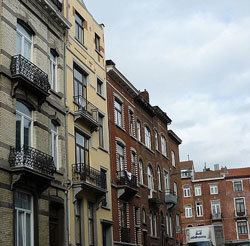Postal codes 1210 Website www.stjosse.irisnet.be Local time Tuesday 9:58 PM Arrondissement Brussels | Region Brussels Area codes 02 Postal code 1210 Area code 02 | |
 | ||
Community Flemish CommunityFrench Community Weather 14°C, Wind SW at 14 km/h, 63% Humidity Points of interest Le Botanique, Botanical Garden of Brussels, Charlier Museum | ||
Saint-Josse-ten-Noode ([sɛ̃ ʒos ten nɔd]) or Sint-Joost-ten-Node ( [sɪn ˈcoːst tɛn ˈnoːdə]) is one of the nineteen municipalities located in the Brussels-Capital Region of Belgium. It is bordered by the City of Brussels and Schaerbeek.
Contents
- Map of Saint Josse ten Noode Belgium
- History
- Demographics
- Mayors of Saint Josse ten Noode
- Culture
- References
Map of Saint-Josse-ten-Noode, Belgium
On 1 January 2007 the municipality had a total population of 23,785. The total area is 1.14 km² which gives a population density of 20,664 inhabitants per km². From a total of 589 municipalities in Belgium, Saint-Josse-ten-Noode is both the smallest in area size and the highest in population density.
History
Named after Judoc, Saint-Josse-ten-Noode was originally a farming village on the outskirts of Brussels. In the centuries before the dismantling of the ramparts encircling Brussels, Saint-Josse-ten-Noode was also the place where noblemen built country estates, the most notable amongst them the Castle of the Dukes of Brabant built by Philip the Good in 1456. The area surrounding that castle was planted with wine groves which explains the presence of the bushel of grapes in the coat of arms of the commune.
After the demolition of the ramparts, Saint-Josse-ten-Noode was one of the first areas outside Brussels to urbanise. The rich built houses around the new boulevards and higher parts of the commune, while industries and workman's cottages were built in the lower lying part close to the River Zenne. In 1855, 58% of the land area of Saint-Joose-Ten-Noode was annexed by the municipality of the City of Brussels to make way for the Squares Ambiorix, Palmerston, Marie-Louise and Marguerite of the newly created Leopold Quarter (now the European Quarter).
According to an inventory of architecture commissioned by the region of Brussels, Saint-Josse-ten-Noode has on average the oldest buildings of all 19 Brussels communes.
Demographics
While foreigners were a majority in 1995, nowadays most of the population has Belgian citizenship, which has resulted in a sharp increase of municipal councillors with a foreign background, benefitting from the open proportional electoral system: from none in 1988 to two (from Morocco) in 1994, a near majority of 13 (seven from Morocco, five from Turkey) out of 27 in 2000 (including three aldermen) and a majority of 20 out of 27 in 2007 (including six aldermen out of seven, the seventh is a member of the Flemish minority).
Mayors of Saint-Josse-ten-Noode
From: Histoire de Saint Josse Ten Noode et de Schaerbeek – Van Bemmel – 1869 and other sources available at the local public library.
Culture
Charlier Museum is devoted to Belgian art of the end of the 19th century.
